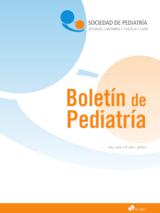Hematuria persistente en Pediatría: ¿cuándo hacer algo más que observar?
J. Martínez Sáenz de Jubera , M. Fernández Fernández
Bol. Pediatr. 2023; 63 (265): 171 - 174
El objetivo principal del estudio diagnóstico de la hematuria persistente es descartar la presencia de patología renal potencialmente grave. La asociación de proteinuria requiere llevar a cabo controles periódicos de función renal, tensión arterial y cuantificación de proteinuria ante la sospecha de glomerulopatía subyacente. La biopsia renal, ante la persistencia de hematuria y proteinuria, nos dará en la mayoría de ocasiones el diagnóstico definitivo. Presentamos el caso de una niña con hematuria controlada en consulta de nefrología infantil durante años sin deterioro del filtrado glomerular en la que se decide realizar biopsia renal, que nos da el diagnóstico definitivo. La nefropatía IgA es la enfermedad glomerular primaria más frecuente en el mundo y requiere seguimiento durante toda la vida por el posible deterioro de la función renal a largo plazo. En la actualidad no existen protocolos específicos de tratamiento para niños, y los más empleados siguen las guías KDIGO 2021, dirigidas a adultos.
Persistent hematuria in Pediatrics: When to do more than observe?
The main goal of the diagnostic study of persistent hematuria is to rule out the presence of potentially serious renal pathology. The association with proteinuria requires periodic monitoring of renal function, blood pressure, and quantification of proteinuria in cases of suspected underlying glomerulopathy. The kidney biopsy, in the presence of persistent hematuria and proteinuria, will often provide a definitive diagnosis. We present a girl with hematuria monitored in pediatric nephrology department for years without deterioration of glomerular filtration in whom it was decided to perform a kidney biopsy, which gave us the definitive diagnosis. IgA nephropathy is the most common primary glomerular disease worldwide and requires lifelong monitoring due to possible long-term deterioration of kidney function. Currently, there are no specific treatment protocols for children, and the most commonly used ones follow the KDIGO 2021 guidelines, which are directed at adults.
Artículo completo (PDF) (289 kb.)
- Nefrourología
Buscar en el boletín
Año 2023, Volumen 63, Número 265

Boletín completo en PDF (8741 kb.)